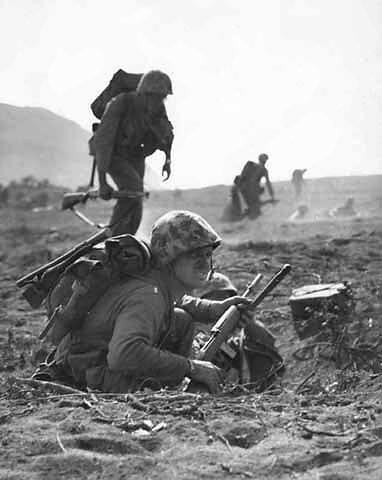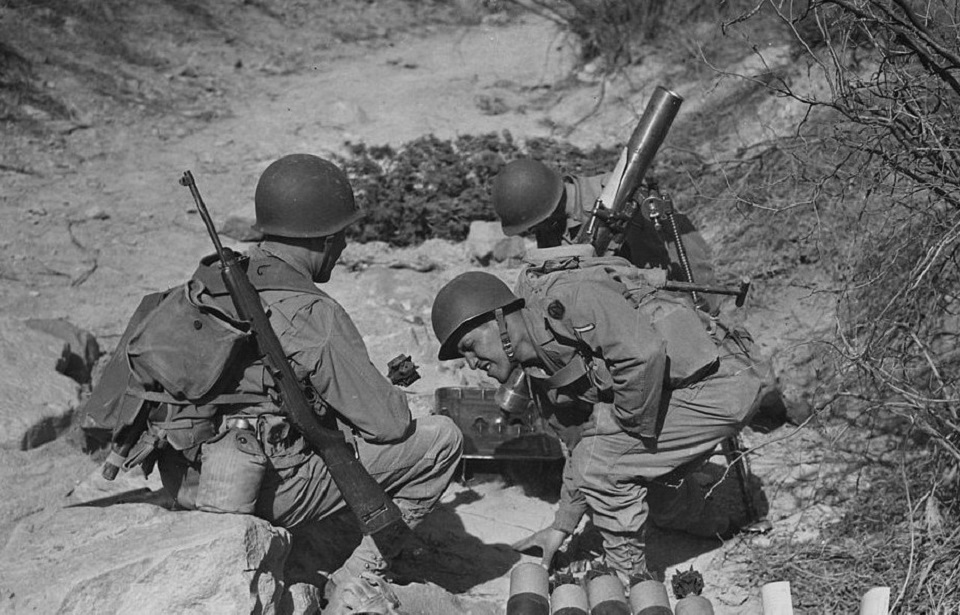The M1 Carbine was a small, lightweight weapon that found itself in the hands of many Allied soldiers during WWII. Its relatively small cartridge led to a number of complaints about its stopping power, but in general, it was loved for its portability and convenience. The M1 Carbine’s purpose and implementation are regarded as revolutionary today.
WWII bore witness to massive game changers in regards to weapons development. Weapons like the MG 34 and 42 helped cement the idea of the general-purpose machine gun, while guns like the FG 42 and STG 44 influenced many post-war designs.
The M1 Carbine was one of these influential designs but was a little unusual as it wedged itself between two well-established roles.
Background
At the time most militaries had weapons to cover most battlefield circumstances. The main battle rifle of the United States was the M1 Garand, which fired the powerful .30-06 cartridge. This rifle could kill a man at well over 1,000 meters away, while its semi-automatic nature made it better at shorter ranged engagements than bolt action rifles.
The Thompson submachine gun covered close quarters’ engagements with its .45 ACP rounds. These powerful pistol rounds were devastating up close but had poor range, accuracy, and penetrative qualities.
After adding in a few other weapons like the Browning Automatic Rifle (BAR) and the M1919 Browning .30 caliber machine gun, this system worked quite well.
However, it was found that while the M1 Garand could kill at long ranges, most WWII engagements took place within 300 meters. This was too far for the Thompson and too close for the Garand to properly stretch its legs. Additionally, the Garand’s large size and the Thompson’s heavyweight made them unwieldy for troops working in tight conditions, like artillerymen, tankers, and truck drivers.
It was clear a new weapon was needed. The small M1 Carbine was this weapon.
The M1 Carbine

The M1 Carbine was a small, semi-automatic carbine that fired the .30 Carbine cartridge from a 15-round box magazine. The gun measured just 35.6 inches (900 mm) long and weighed only 5.8 lbs (2.6 kg) fully loaded – compared to the Garand’s 43.5 inches (1,100 mm) length and mass of 11.6 lb (5.3 kg) fully loaded. Although it is a carbine, it was an entirely new weapon and wasn’t based on the Garand.
Its .30 Carbine cartridge was significantly smaller and less powerful than the Garand’s .30-06 but had more range, accuracy, and penetration than the Thompson’s .45 ACP. Plus, thanks to the small size of both the weapon and its ammunition, a soldier could carry more ammunition.
It uses a short-stroke gas piston system designed by David Marshall Williams, an American gunsmith who started designing weapons while servicing in prison for murder. Winchester developed the rifle, using Williams’ system, and the cartridge. It was accepted into use by the US Army in October 1941.
The M1 Carbine provided a small, portable weapon with adequate power for non-combat troops in roles where a large weapon was a hindrance. It came at the perfect time too, as the M1 Garand was in short supply and desperately needed by frontline infantrymen, while the Thompson was far too expensive to be placed in non-combat roles.
Service

When it arrived in the hands of troops it quickly became a popular weapon. Radiomen, Staff NCOs, paratroopers, tankers, and bazooka crews all loved the Carbine, as it added little weight to their kit and could be tucked out of the way. The M1A1 variant went a step further and added a folding stock, reducing its stowed length to just 25.7 inches (650 mm).
The M1 Carbine proved to be effective in battle too, outranging the Thompson and providing a decent output of fire up to around 300 meters. Its penetrating power meant it was able to hit enemies behind thin cover, making it ideal for the jungle battles fought all over the Pacific. Later variants were fully automatic, with a rate of fire of about 750-775 rounds per minute.
However many frontline troops reported that the M1 Carbine had insufficient stopping power even after hitting someone multiple times.
Regardless, this little weapon was a remarkable footnote in the history of weapon development. It sits in quite a unique position, as it is more powerful than a pistol, more accurate and longer-ranged than a submachine gun but much less powerful than a battle rifle. Some argue that in its fully automatic variants, the Carbine was an early assault rifle, firing an intermediate round.
Although the .30 Carbine wouldn’t be considered intermediate today, back then it was sandwiched between the .45 ACP and the .30-06.
Some put the fully-automatic Carbines down as precursors of the modern personal defense weapon (PDW).
The small weapon has seen action in some of the 20th Century’s most prominent wars and is still in use in small numbers today.
